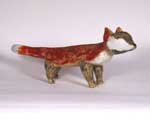From the collection of:
Kentucky Folk Art Center || VAM Home
Minnie Adkins (Kentucky, b. 1934)
FOX, 1985
Painted wood; 12-1/2" X 32" X 6"
1989.5.28
Kentucky Folk Art Center
The fox is a frequent subject for carver Minnie Adkins. This example was an early experiment by the artist as she first began to create larger pieces. Later on in her career, Minnie Adkins’ foxes became more stylized. Typically painted bright red, they have white tips on their tails and menacing, open mouths exposing razor-sharp teeth. In making this particular fox, the artist was exploring new ideas. She produced a piece that is easily recognized as a fox—but a fox that seems friendly, almost shy, and not the least bit threatening.
About the Artist
Minnie Adkins traces her interest in making things back to her childhood, when she would watch the men in her community whittle. Carving is not traditionally a female pastime, but Adkins began carving at an early age, making small twig roosters, hand-sized birds, and other small objects. While she and her first husband, Garland, lived in Fairborn, Ohio, from the 1950s into the 1970s, she continued carving, giving most of her work away to family and friends and occasionally selling pieces at flea markets.
In 1984, Adkins took some small carvings to a gallery in Morehead, Kentucky, and the gallery began handling some of her pieces. In 1985, her work became part of the folk art collection at Morehead State University—which would become the Kentucky Folk Art Center. Husband Garland helped her with various parts of the process until his death in 1997, and from the early 1980s until 1997 all of her work was signed “G&M Adkins.” (One of Garland Adkins’ solo works, Horse, is also featured in our Kentucky Folk Art Center gallery.)
Over the years, Minnie Adkins has received several prestigious awards, including a Kentucky Governor’s Award in the Arts Individual Artist Award. Her work has been exhibited widely and is in several museum collections. She is well known for her “twig” roosters, ranging in height from three inches to four feet, and for carved and painted wooden animals up to 30 inches long. Most of her wood carvings are painted.
Adkins also has encouraged many other Eastern Kentucky folk artists to sell and exhibit their work. In 1987, she and Garland began hosting an annual folk art fair, “A Day in the Country,” at their home. The event is now presented by the Kentucky Folk Art Center, attracting approximately 50 folk artists and hundreds of collectors to Morehead each June.
Minnie is remarried to Herman Peters, a retired master welder who makes metal versions of her animal forms, mostly out of recycled cast-iron (“black”) pipe. The couple live and work near Isonville.
Minnie talks about her work and the Day in the Country fair and shows how she makes roosters on the Visual Arts Toolkit video segment “Wooden Animals: Minnie Adkins,” found in Part 5: Folk/Traditional Arts of the Spectrum of Art DVD.
Classroom Ideas
Discussion: Describe Fox. How did the artist use the elements of art in this piece? What does this sculpture suggest to you about the artist’s attitude toward this animal? What might Fox tell us about the artist at the time this piece was made? What is your opinion of the piece? Do you think it portrays qualities of a real fox, such as color and size, or the spirit of a fox? Use specific details that reference the artwork in your response.
Compare this fox to Minnie Adkins’ later foxes and other animals she has created and to other animal carvings in the Kentucky Virtual Art Museum. Compare one of her foxes to a work showing an imaginary creature, such as the Roach Terminator shown on the Visual Arts Toolkit video segment on Adkins.
Activities: Choose a type of fox or other animal that interests you and list characteristics of its appearance and its character or spirit. How would you convey these qualities using the elements of art, such as color and form? Sketch the animal using basic shapes. Using the sketch as a guide, construct an armature and cover it with glue-soaked newspaper strips to create a papier-mâché sculpture of your animal. Paint your sculpture in real or fantasy colors.
Read Minnie Adkins’ children’s book Bright Blue Rooster. Write a story about the animal you created.
Links
More information and images of Adkins’ work, along with advice on collecting folk art, can be found at the Self-Taught Folk Art web site.
[alumnus.caltech.edu/~dacrotty/adkins.html]
When I Win the Doctor Thing, an article on Adkins by Kentucky Folk Art Center Curator Adrian Swain, can be found at the Folk Art Society of America web site.
[www.folkart.org/mag/adkins/adkins.html]
See more images of works by Minnie and Garland Adkins at the Jane’s Addictions visionary art web site.
[www.janesaddictions.com/adkins01.htm]
A biography and numerous images of Adkins’ work are included in Minnie’s Gallery at folk artist Jim Lewis’ web site.
[victorian.fortunecity.com/operatic/611/minniesgallery.htm]


